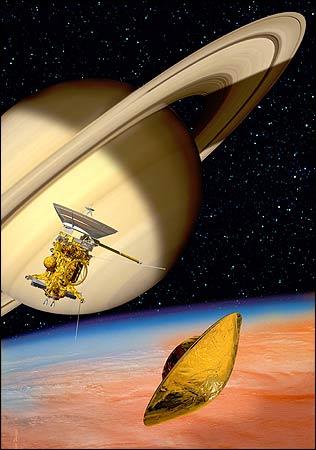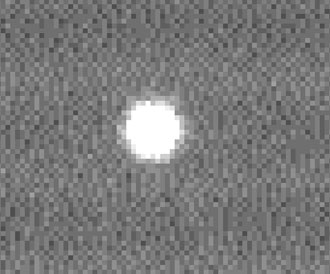Data on the success of the separation mission arrived this morning to the people of the control center in Pasadena

25.12.2004
The Cassini spacecraft releases Huygens towards Titan. NASA imaging.
The European research probe detached from the Cassini spacecraft and began to descend towards the mysterious moon of Saturn. "In some ways it's a journey to the early Earth," said David Southwood, ASA's science program director.
The European research probe "Huygens" detached from NASA's research spacecraft "Cassini" on Friday, and began its dive to Titan - Saturn's mysterious moon. The researchers hope that Huygens' journey will shed some light on one of the most mysterious space bodies in the solar system.
Engineers at NASA's control center in California received a signal Friday evening that Huygens had detached from Cassini, as small explosions loosened the screws and locks and a series of springs gently nudged the probe onto a collision course with Titan.
Huygens will be "dormant" for the next three weeks and will float to Titan in this state. It will "wake up" just four hours before entering Titan's atmosphere - on January 14. Huygens, a forced creation of the European Space Agency, is supposed to provide information about the only moon in the solar system that has an atmosphere and surface that may not be solid. The truth about this moon, scientists believe, is almost certainly stranger than any science fiction story. "There are several books on the subject... and I'm sure they're all wrong," said Jean-Pierre Leverton, the Huygens project manager at ESA, the European Space Agency.
A favorite arena for science fiction authors, Titan is larger than the planets Mercury and Pluto. Its atmosphere, like Earth's, is mostly nitrogen, but temperatures on Titan's surface are about 180 degrees below zero, making it a particularly inhospitable place for humans. "In some ways it's a journey to the early Earth," said David Southwood, ASA's science program director.
One of the biggest questions, Southwood and colleagues said, is whether there is any liquid on Titan's surface, such as lakes filled with methane rain. Scientists hope that Huygens will provide an answer to this question after it has already traveled 3.5 billion kilometers to Saturn for 7 years, in the lap of NASA's Cassini spacecraft. Huygens, which is about 2.7 m wide and somewhat similar to a flying saucer, is supposed to land safely for about two and a half hours through Titan's atmosphere, using three parachutes designed to slow down its speed and allow the instruments on it to carry out detailed tests.
Once it reaches Titan's surface – assuming there is solid terrain to crash into – researchers expect the probe to remain operational for only a short time, perhaps no more than 30 minutes, before its batteries run out. "We have a very faint idea of the surface," said Southwood, "We don't know if Huygens will fall into a liquid, or if it will crash on a solid surface."
Huygens successfully released from Cassini and is on track to land on Titan on January 14
The European Huygens spacecraft broke the cables connecting it to NASA's Cassini mothership and began its journey towards the mysterious Saturnian moon Titan. She began a journey that scientists hope will end in providing answers about the nature of one of the most enigmatic bodies in the solar system.
Ground controllers received signals on Saturday at 19:24 West Coast Time (05:24 Israel time on Saturday morning) indicating that Huygens had separated from Cassini, when a small explosion caused the cables connecting the spacecraft to disconnect and a series of loose springs began to push Huygens. on a collision course with Titan.
Now it only remains to examine the speed of the spacecraft and the speed of its rotation around an axis. The spacecraft will remain dormant until a few hours before entering the atmosphere, as stated on January 14, 2005.

The photograph of Huygens moving away from Cassini (from the NASA website)
Cassini is ready for Huygens release today (actually early Saturday morning)
24/12/2004
With a gentle push, Cassini will launch the European Space Agency's Huygens spacecraft into an orbit that should bring it into the atmosphere of Saturn's largest moon, Titan.
The Huygens spacecraft must be released precisely into orbit because it has no navigation and maneuvering capabilities of its own, and will remain dormant until a stopwatch wakes it shortly before entering Titan's hydrocarbon-rich atmosphere and parachutes it until it reaches Titan's surface on January 14.
Confirmation of the successful disconnection should reach the antennas of NASA's Deep Space Network in Spain and Goldstone, California shortly before 11:06 PM on Friday EST (00:XNUMX AM EST).
The Cassini-Huygens mission, a joint project of NASA, the European Space Agency and the Italian agency, and whose estimated cost is 3.3 billion dollars, was launched on October 15, 1997 from Cape Canaveral, to study Saturn, its spectacular rings and its many moons.
During the seven years it took Cassini to reach Saturn, the Huygens spacecraft attached to it was attached to it by an umbilical cord and powered by Cassini's electricity. Huygens woke up every six months for experiments. Cassini entered Saturn orbit in June and since then several flybys of Titan have been conducted in preparation for the Huygens release.
Tonight, springs that have remained taut until now will propel the Huygens into free fall toward Titan. On Monday, Cassini itself will make a course change to avoid itself falling towards Titan in the wake of Huygens.
Huygens is scheduled to levitate and descend for two and a half hours using a parachute until it reaches the surface of the moon, which, according to some theories, may contain lakes of methane.
The instruments on board the spacecraft will study the chemistry of the atmosphere and the cameras will try to record images from the surface. It is not yet known whether it will land on liquid or solid surfaces, and if indeed these will be terrestrial surfaces, it will even be able to survive on them for a few minutes.
As long as its instruments are working, Huygs will transmit the data back to Cassini, which will point its large antenna at it. Later, when it's all over, Cassini will turn the antenna toward Earth and transmit the findings to the European Space Agency's operations center in Darmstadt, Germany.
For the news, Bard Nova
